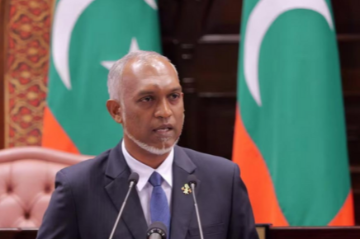There is a need to examine the facts, analyse the implications, and draw some lessons from this incident.
Asaphila is approximately 100 sq km of remote mountainous (average height 2000 meters) area, covered with dense thick forest along the Line of Actual Control (LAC) in Upper Subansiri Division of Arunachal Pradesh. It is very sparsely populated. Other than some tribal shikar trails, the only foot tracks are along Yume Chu and Chayul Chu, two distributaries of Subansiri River. The nearest road head on the Indian side is Tame Chung Chung. About 50 km ahead toward the LAC is the last Indian Post ,Taksing, which is on the Eastern edge of Asaphila area. The Chinese are not placed any better; their road head and posts, Lung and Tadang, are approximately 35-40 km away.
There is no clear watershed in Asaphila area. Foot movement is possible round the year. As the Indian and Chinese perceptions of the LAC are wide apart, and not delineated, it is one of the eight 'disputed' areas recognised by both sides.
On June 26, 2003, an Indian non-military patrol, comprising two police personnel, three porters and five men of SSB, moving upstream along Yume Chu decided to take a break. They were resting non-tactically when a stronger 22 men Chinese patrol from the other side surprised them. The Chinese took away their arms and then escorted them back upto the Indian observation post. There they hailed an officer, claimed that the Indian patrol had entered their area, handed over Indian personnel with their weapons, and then went back.
Let us put this incident into its perspective. Ever since India and China signed the Agreement on Confidence Building Measures in the Military Field in 1996, there has been no firing incident along the LAC. But Army and Para-military forces patrol face-offs have often taken place in the 'disputed' areas including Asaphila. In most cases, both patrols have exercised self-restraint (as per Article 7) and returned after registering respective claims to the area. In some instances, there have been angry exchanges with tension rising high but the patrol leaders have not permitted the situation to get out of control. Significantly, they have neither attempted, nor allowed, to disarm each other.
In this particular incident, the Chinese patrol disarmed the Indian patrol; a highly objectionable act, in clear violation of Articles 6 & 8 of the Agreement. A protest has, therefore, been lodged, which was totally justified. If there were to be another such attempt, it would definitely lead to a firing incident. (No one is expected to hand over weapons without a fight. How did that happen this time?)
The 1996 Agreement also provides a mechanism of flag meetings by military commanders on both sides to resolve tactical problems. Unfortunately, the agreed locations for such meetings are far apart and the meetings are very few. Flag meeting location that covers Asaphila area is far away, in area Bumla of Kameng Division.
What then are the lessons at the local and tactical level?
-
There must be no complacency in patrolling. The patrols must be adequately strong, well trained, and should remain alert.
-
We must not send untrained, ad hoc non- military patrols in sensitive areas.
-
There is a need to establish more flag meeting points along the LAC, particularly in or near the disputed areas.
-
The Joint Working Groups must expedite delineation of respective LAC claims. Meanwhile, a jointly agreed, detailed SOP should be prepared and laid down for adherence in face-off situations.
Asaphila patrolling face-off of June 26 was no doubt a tactically important event that required an immediate response at that level (Flag Meeting). Only if that did not produce results, the level needed to be raised. When seen in a perspective and at macro level, however, it did not call for the media hype or a national debate that could affect a sensitive foreign policy issue of the on going Sino Indian dialogue to improve relations. Several journalists and political leaders in and outside the Parliament over- reacted on this incident and hinted at changes in the national policy on China. Was that necessary? Why did that happen?
Much of the blame for this can be attributed to the Government's media policy and its inability to move forward with the times. Despite several positive and negative lessons in the past, we continue to maintain antiquated Public Relations (PR) establishments in most ministries/departments. Except in the Ministry of External Affairs, where an IFS Joint Secretary spokesperson holds media briefings every other day, there are no such spokespersons. Where they do, they are horribly ill informed and decline to say anything without the Minister's approval. As someone has remarked, "Those who know, are scared of talking; and those who do not, talk too much."
The Government must realise that after the Kargil intrusion, public expects information and explanation, particularly when there is any news or rumor of such an incident. On the other hand, with over 15750 km long land borders (nearly one third of that is disputed), and 7685 km long coastline, such patrolling face-offs are bound to take place occasionally. If an official explanation is not given quickly, the incident is bound to be misreported and distorted, leading to undesirable over- reactions. It happened in Machel incident (often referred to as Kargil 2 in the media), where despite good surveillance and excellent combat action, the Army came in for unnecessary flak. Unfortunately, this sort of thing is happening fairly regularly now. The rank and file in the Army is bound to feel concerned. Further, public and political over reaction can make the troops on the ground defensive in attitude and shy of talking or reporting such incidents immediately.
In the given incident, a timely statement and clarifications by a spokesperson from the Ministry of Home Affairs or Defence in Tezpur or in Delhi would have closed or kept the issue at its correct level.
In the Information Technology driven media age, 'every one to keep his mouth shut' will be counter productive. We must modify our policies on the Official Secret Act, adopt a pragmatic information policy, and create suitable organizations in each Ministry/Department to implement it.
*Former Chief of Army Staff. Currently President ORF Institute of Security Studies, New Delhi.
The views expressed above belong to the author(s). ORF research and analyses now available on Telegram! Click here to access our curated content — blogs, longforms and interviews.




 PREV
PREV

